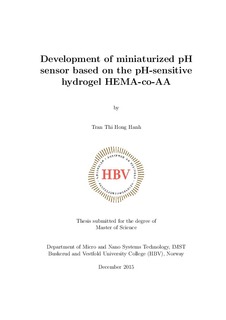| dc.description.abstract | The hydrogel biosensor is one of promising BIOMEMS (Biomedical Microelectromechanical system) devices with vast of applications in biomedical field. This project aims to develop a pH biosensor based on pH responsive hydrogels a piezoresistive pressure sensor capable of monitoring ambient pH as a signature of the physiological health status of a cell culture (in vitro), tissue or organ (in vivo). The hydrogel 2-hydroxyethyl methacrylate-o-acrylic acid (HEMA-co-AA) was chosen to be incorporated into a cavity of a piezoresistive pressure sensor. The hydrogel was synthesized and investigated separately within the fabricated SU8 photoresist cavity where hydrogel can only expand or shrink in one direction. When immersing the hydrogel into the pH buffers, the percentage of volume change of the hydrogel was determined indirectly by a profilometer. The hydrogel samples with thickness from 77-110 µm performed the expansion degree of 55-77% at low pH 2-4 and of 130-195% at higher pH 5-11. Both the equilibrium time and the maximum expansion of hydrogel samples were influenced by their thickness. Practical experiments also showed that there is a hysteresis of the hydrogel response which can be accounted for a delay of the protonation to deprotonation mechanism. Results indicated that the hydrogel sample after hydration should be stored in suitable pH buffer. The design of the front-end hydrogel sensor electronics and packaging procedure was made. The hydrogel HEMAco-AA 4:1 (molar ratio) after characterization was in situ synthesized in the cavity of a piezoresistive pressure sensor. The hydrogel sensor was involved in two different packaging processes. Results showed an increase in the electrical signal of the hydrogel, proving that the hydrogel can generate a pressure on silicon diaphragm of the pressure sensor. The specific hydrogel incorporated into the cavity of the pressure sensor was reached to equilibrium status in approximately 7 hours. However, the hydrogel sensor could not stay stable in the solution for long period of time due to the properties of packaged adhesives toward solution. The problems were pointed out for future improvements. | nb_NO |
